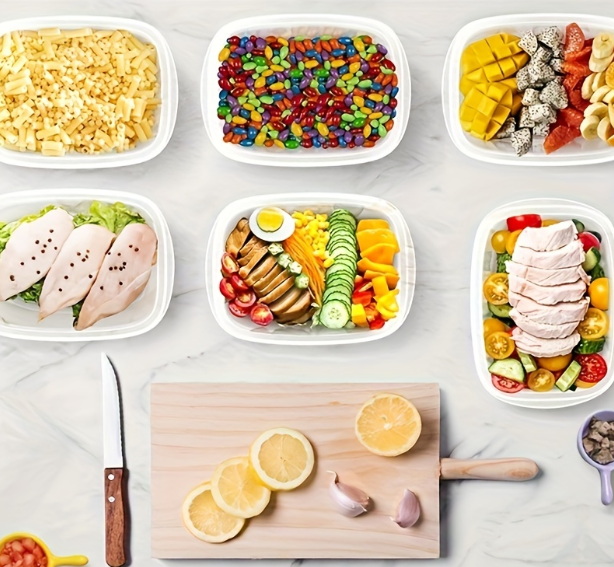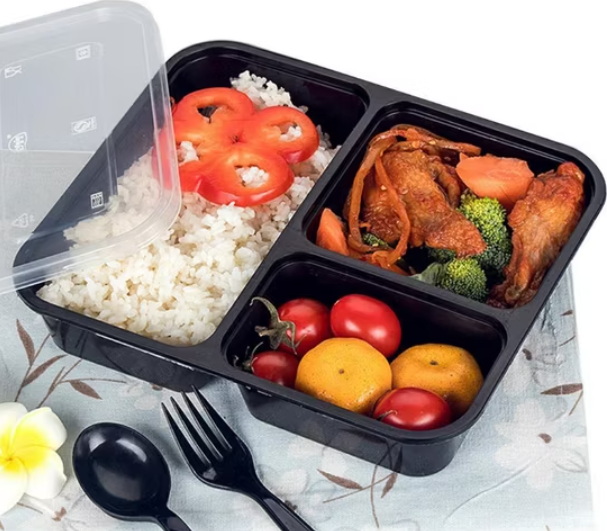
Content Menu
● Understanding Disposable Food Boxes with Lids
● Key Materials Used in Safe Disposable Food Boxes with Lids
>> Plastic-Based Materials
>>> Polypropylene (PP)
>>> Polyethylene Terephthalate (PET)
>>> High-Density Polyethylene (HDPE)
>>> Low-Density Polyethylene (LDPE)
>>> Polystyrene (PS) and Expanded Polystyrene (EPS/Foam)
>>> Polylactic Acid (PLA)
>> Paper-Based Materials
>>> Uncoated Paperboard
>>> Coated Paperboard (PE or PLA Coating)
>> Plant-Fiber Materials
>>> Bagasse (Sugarcane Fiber)
>>> Bamboo and Wooden Containers
>> Aluminum
● Safety Considerations in Disposable Food Boxes with Lids
>> Food-Grade Certification
>> Temperature Resistance
>> Chemical Leaching
>> Reusability and Single-Use Guidelines
● Environmental Impact and Sustainability
● Choosing the Right Disposable Food Box with Lid
● Conclusion
● FAQ: Disposable Food Boxes with Lids
>> 1. What is the safest plastic for disposable food boxes with lids?
>> 2. Are disposable food boxes with lids microwave-safe?
>> 3. Can disposable food boxes with lids be recycled or composted?
>> 4. Are there eco-friendly options for disposable food boxes with lids?
>> 5. Is it safe to reuse disposable food boxes with lids?
Disposable food boxes with lids have become an indispensable part of daily life, especially with the rise of takeout culture, meal delivery services, and the need for convenient food storage solutions. These containers are designed to keep food fresh, safe, and easy to transport, but the type of material used in their manufacture can significantly impact their safety, environmental footprint, and suitability for different foods. In this comprehensive guide, we'll explore the materials most commonly used in safe disposable food boxes with lids, their properties, benefits, and considerations for both consumers and businesses.

Understanding Disposable Food Boxes with Lids
A disposable food box with lid is a single-use container designed to store, transport, and sometimes reheat food. The lid serves as a barrier to protect the contents from contamination, retain moisture, and prevent spills. These containers are available in an array of shapes, sizes, and materials, each tailored for specific uses such as hot or cold foods, liquids, or dry snacks.
Key Materials Used in Safe Disposable Food Boxes with Lids
Plastic-Based Materials
Plastic remains one of the most popular choices for disposable food boxes with lids due to its versatility, durability, and cost-effectiveness. However, not all plastics are created equal when it comes to food safety and environmental impact.
Polypropylene (PP)
Polypropylene is a lightweight, durable plastic that is highly resistant to heat. It is often used for disposable food boxes with lids that need to withstand microwaving or hot foods. Polypropylene does not react with acidic or oily foods, making it a safe choice for a wide range of dishes. It is also widely recyclable, making it a practical option for both consumers and businesses looking for a balance between safety and sustainability.
Polyethylene Terephthalate (PET)
PET is a clear, strong plastic commonly used for cold food storage. It provides an excellent barrier against moisture and gases, helping to keep food fresh. While PET is not suitable for high-heat applications, it is widely recycled and is a popular choice for salad containers, deli boxes, and beverage cups with lids.
High-Density Polyethylene (HDPE)
HDPE is known for its strength and resistance to chemicals and moisture. This material is safe for both hot and cold foods and is commonly used in larger food storage containers. Like polypropylene, HDPE is widely recyclable and is a reliable material for sturdy disposable food boxes with lids.
Low-Density Polyethylene (LDPE)
LDPE is more flexible than HDPE and is often used for soft lids or flexible containers. It is safe for food contact but is less heat-resistant, making it better suited for cold or room-temperature foods. LDPE can be recycled in some areas, although it is less commonly accepted than HDPE or PET.
Polystyrene (PS) and Expanded Polystyrene (EPS/Foam)
Polystyrene, especially in its expanded foam form, is lightweight and provides good insulation. However, it is not recommended for hot foods or microwaving, as it can leach chemicals when exposed to heat. Environmental concerns have led to increasing restrictions on the use of foam containers, and they are generally more challenging to recycle.
Polylactic Acid (PLA)
PLA is a bioplastic made from renewable resources such as corn starch. It is biodegradable and compostable under industrial conditions, making it an attractive option for eco-friendly disposable food boxes with lids. However, PLA is only suitable for cold foods and requires specific composting facilities for proper disposal.
Paper-Based Materials
Paper-based disposable food boxes with lids are often chosen for their sustainability and versatility. They can be made from uncoated or coated paperboard, each offering different levels of protection and recyclability.
Uncoated Paperboard
Uncoated paperboard is lightweight, biodegradable, and compostable. It is best suited for dry foods, as it can absorb moisture and oils. These containers are easy to recycle and are commonly used for bakery boxes, sandwich boxes, and dry snack containers.
Coated Paperboard (PE or PLA Coating)
To enhance moisture and grease resistance, paperboard can be coated with a thin layer of polyethylene (PE) or polylactic acid (PLA). The type of coating affects the container's recyclability and compostability. PE-coated paper is more challenging to recycle, while PLA-coated paper is compostable in industrial facilities. These containers are suitable for soups, noodles, and hot foods.
Plant-Fiber Materials
Plant-fiber-based materials are gaining popularity as sustainable alternatives to traditional plastics.
Bagasse (Sugarcane Fiber)
Bagasse is a byproduct of sugarcane processing and is fully biodegradable and compostable. It is heat-resistant and sturdy, making it suitable for both hot and cold foods. Bagasse containers are free from chemicals and can be composted at home or in industrial facilities, making them a top choice for eco-friendly disposable food boxes with lids.
Bamboo and Wooden Containers
Bamboo and wood are renewable, naturally antimicrobial materials that are safe for direct food contact. These containers are biodegradable and compostable, and they add a premium, natural look to food presentation. Bamboo and wooden boxes are commonly used for sushi, salads, and upscale takeout options.
Aluminum
Aluminum containers are lightweight, heat-resistant, and provide an excellent barrier against light, moisture, and oxygen. They are safe for food contact but may react with acidic foods. Aluminum is highly recyclable and is often used for takeout trays, oven-ready meal boxes, and foil food boxes with lids.

Safety Considerations in Disposable Food Boxes with Lids
Food-Grade Certification
It is crucial that disposable food boxes with lids are made from food-grade materials. Regulatory agencies require manufacturers to use materials that do not leach harmful chemicals into food, especially under heat or acidic conditions. Always look for containers labeled as "food grade" or "BPA-free" to ensure safety.
Temperature Resistance
Not every material is suitable for all temperatures. Polypropylene and bagasse are safe for microwaving and hot foods, while PET and PLA are best for cold foods. Using the wrong material for hot or reheated foods can lead to warping, melting, or chemical leaching.
Chemical Leaching
Certain plastics, especially those not certified as food-grade or those containing BPA, can leach chemicals into food, particularly when heated. HDPE, LDPE, and PP are among the safest plastics for food contact, while polystyrene and PVC should generally be avoided for hot foods or microwaving.
Reusability and Single-Use Guidelines
Disposable food boxes with lids are designed for single use. Reusing them, especially after exposure to heat or repeated washing, can increase the risk of chemical migration and contamination. For repeated use, choose containers specifically designed for durability and safety.
Environmental Impact and Sustainability
The environmental impact of disposable food boxes with lids is a growing concern. Traditional plastics can persist in the environment for centuries, while plant-fiber and biodegradable options offer more sustainable solutions. When choosing disposable food boxes, consider:
- Recyclability: PET, PP, and aluminum are widely recyclable if cleaned properly.
- Compostability: Bagasse, bamboo, and PLA-based containers can be composted, reducing landfill waste.
- Source Material: Plant-based and recycled content options help reduce reliance on fossil fuels and virgin materials.
Choosing the Right Disposable Food Box with Lid
When selecting a disposable food box with lid, consider the following factors:
- Type of Food: Hot, cold, dry, or greasy foods may require different materials.
- Intended Use: For microwaving, choose polypropylene or bagasse; for cold salads, PET or PLA is suitable.
- Sustainability Goals: Opt for compostable or recyclable materials whenever possible.
- Safety Certifications: Look for "food grade," "BPA-free," and relevant recycling codes.
- Seal Quality: Ensure the lid fits securely to prevent leaks and maintain freshness.
Conclusion
The materials used in safe disposable food boxes with lids play a vital role in ensuring food safety, convenience, and environmental responsibility. From versatile plastics like polypropylene and PET to sustainable alternatives like bagasse, bamboo, and PLA, each material offers unique advantages and considerations. By understanding the properties and best uses for each material, consumers and businesses can make informed choices that align with their health, safety, and sustainability priorities. As the demand for convenient food packaging continues to grow, so too does the importance of selecting the right disposable food box with lid to meet the needs of both people and the planet.

FAQ: Disposable Food Boxes with Lids
1. What is the safest plastic for disposable food boxes with lids?
Polypropylene is widely regarded as the safest plastic for disposable food boxes with lids. It is heat-resistant, microwave-safe, and does not leach harmful chemicals into food. High-density polyethylene and polyethylene terephthalate are also considered safe for food contact when used appropriately.
2. Are disposable food boxes with lids microwave-safe?
Not all disposable food boxes with lids are microwave-safe. Polypropylene and bagasse containers are generally suitable for microwaving, while PET, PLA, and polystyrene (foam) should be avoided in the microwave. Always check for microwave-safe labeling before reheating food in these containers.
3. Can disposable food boxes with lids be recycled or composted?
Recyclability and compostability depend on the material. PET, polypropylene, and aluminum containers are widely recyclable, while bagasse, bamboo, and PLA containers are compostable in appropriate facilities. Always check local recycling and composting guidelines for proper disposal.
4. Are there eco-friendly options for disposable food boxes with lids?
Yes, there are several eco-friendly options, including boxes made from bagasse (sugarcane fiber), bamboo, PLA (corn-based plastic), and recycled paper. These materials are biodegradable or compostable, making them more sustainable than traditional plastics.
5. Is it safe to reuse disposable food boxes with lids?
Disposable food boxes with lids are designed for single use. Reusing them, especially after exposure to heat or repeated washing, may lead to chemical leaching and reduced structural integrity. For repeated use, choose containers specifically labeled as reusable and food-safe.

















